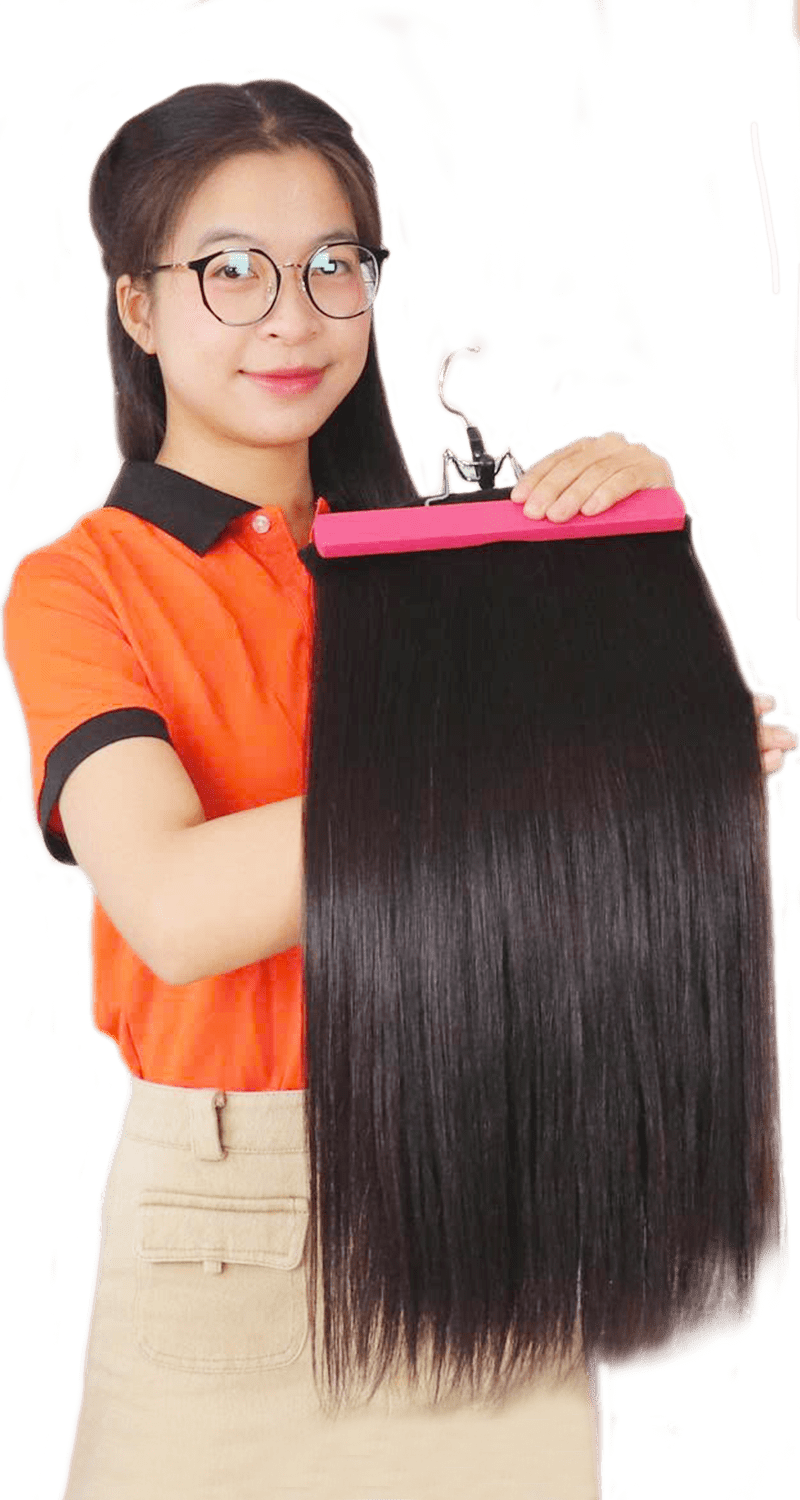Have you ever purchased a wig or lace frontal that simply would not blend in with your skin, despite your best efforts? Does it not matter how much foundation you put on that lace, the fact that it still makes your forehead and portion look like a screen door? The pleasure of wearing a wig can be completely ruined if the lace is of poor quality or the lace technique is performed incorrectly. The usage of lace, which is a fabric that is both delicate and elegant, can result in the creation of spectacular items of apparel and hairpieces. However, not every piece of lace is the same quality.
Diverse types of lace exist, and while some excel in quality, others fall short. Within this blog post, we are going to go over several pointers that will help you differentiate between quality lace and subpar lace. Whether you seek a lace frontal or a wig to perfect your appearance, we’ve got you covered. So, let’s get started!
I. Identify Good Lace and Bad Lace: Unveiling the Lace Types
To grasp the aspects of quality in lace frontals and closures, it’s crucial to acquaint ourselves with the diverse lace varieties employed in their crafting. Lace has truly transformed the landscape of the wig sector, granting users an imperceptible hairline and the flexibility to fashion their hair according to their preferences. Two popular choices that have gained recognition for their seamless and natural-looking qualities are Swiss lace and HD lace.

Spanning from Swiss lace to HD lace, every type of lace exhibits unique attributes that impact its overall functionality. Among these, Swiss lace reigns as the prevalent choice for wigs, hairpieces, and hair extensions, cherished for its balance of affordability and premium quality. Available in an array of hues, Swiss lace seamlessly complements diverse skin tones. On the other hand, HD lace represents a technological leap in the lace domain. Crafted with cutting-edge materials, this ultra-thin and translucent lace achieves an almost imperceptible hairline, marking a remarkable advancement in the realm of lace innovation.
II. Identify Good Lace and Bad Lace - The Sign Of Low-Quality Lace
There is nothing more disheartening than spending your own hard-earned money on a wig or lace frontal only to discover that it is of a lower quality than you expected. To address this issue, our aim is to help you discern the common traits and telltale signs of subpar lace, enabling you to avoid such purchases in the future. The following are the top 5 ways to identify a frontal that is not worth your hard-earned money that is hidden in the lace:
Sign of Low-quality Lace #1: Thick Lace of Poor Quality
To be able to assure a seamless installation and look, lace frontals need to be manufactured from thin and delicate lace. This allows the lace to be easily trimmed, laid flat, and blend in perfectly with the skin around your hairline. This is essential for achieving a natural-looking and seamless appearance.

If the lace is thick, it almost always indicates that it is of a lower quality than other sorts of lace and that the finished product will not have the appearance of being natural. You might think it seems OK from afar, but after giving it a closer look and paying more attention to the finer details, you might come to the conclusion that its quality is simply not on par with that of lace of a higher grade.
#2: Poor Lace Pattern
Regardless of whether or not a lace has been treated with heat, it is imperative to perform a thorough inspection of its fine intricacies before making a purchase of that lace. If the pattern of the lace is not constant or if you discover any holes in its stitching, it may be a sign of poor craftsmanship and a signal that the frontal will not deliver on what you anticipate it to deliver. In addition, if you have acquired a full lace wig and discovered that there are size differences between the synthetic hair and the human hair foundation, this is another indication that the lace is of poor quality. If you have this problem, you should return the wig.

Sign of Low-quality Lace #3: The Color Does Not Match Your Skin Tone

When making a choice for a wig or frontal, giving meticulous thought to the lace color is absolutely crucial, as this element holds paramount importance. Achieving the illusion of absolute naturalness hinges upon selecting lace that precisely matches your skin tone. Most inferior-quality lace tends to have an off-white hue, which not only makes it look unnatural but also makes it stick out and appear quite artificial.
#4: Does Not Hold Up Well With Heat
A high-quality lace frontal should possess the capability to endure heat styling and dyeing. If you’ve observed that your frontal struggles to withstand heat, it’s probable that it’s of inferior quality or was not crafted with proper manufacturing. Prioritizing the assessment of lace quality and construction before making a purchase is advisable, as this precaution can spare you considerable time, money, and frustration down the road.
Sign of Low-quality Lace #5: Poorly Structured Hairline

When considering the hairline of a lace frontal, any indication of its presence should be entirely absent. The hair distribution must be uniform, and the lace should seamlessly merge with your scalp. Any evidence that the wig’s structure is lopsided or clustered is a definite indicator that the lace is of lower quality.
III. Identify Good Lace and Bad Lace - The Sign Of High-Quality Lace
There are a number of characteristics that you have to be on the lookout for in a lace frontal in order to make certain that you get one of high quality. These are the following:
Sign of High-quality Lace #1: Thin and Delicate Lace

When it comes to creating a hairline that seems completely natural, the quality of the lace that is utilized can make all the difference in the world. Because it is simpler to manipulate and cut than other types of lace, thin and fragile lace that is virtually see-through will be the finest choice for this project. The majority of lace front wigs available on the market are constructed with this type of lace because it enables a natural-looking mix with the wearer’s own scalp. Before you buy a lace wig, whether it’s a frontal or a full lace front wig, you should always double-check the quality of the lace and make any necessary adjustments if necessary.
#2: Evenly Distributed Hairline
When compared to the hairline of your own scalp, the hairline of a professionally produced frontal should have an even distribution of hair and appear natural. The quality of the lace should be dense enough to support the hairs in a way that looks natural, and the hairs themselves should be featured in a way that looks natural. If you see any big gaps in the hairline, this is a sign that your frontal has been made with low-quality lace, and as a result, it will not survive as long as a frontal that has been constructed with higher-quality lace.
Sign of High-quality Lace #3: Perfectly Match Your Skin Tone
When we are discussing HD lace wigs, the color of the lace is the single most significant factor to take into consideration. In order for the lace to look natural, you need to make sure that the color of the lace comes as near as it can to match the color of your skin. If you have lace that is an off-white or greyish color, it will not integrate well with your scalp and will make you appear to have an artificial hairstyle.

In order to prevent this from happening, it is essential to make certain that you get the appropriate shade of lace. Comparing the lace to a sample of your skin, taken from either your arm or your face, is an excellent method for achieving this goal. Using this information as a reference, you will be able to choose a wig that comes in a shade that is the most similar to your natural complexion when you go to buy one.
#4: Quality Hair
When it comes to choosing a human hair lace front wig, the quality of the hair should be given the same amount of consideration as the quality of the lace itself. For the strands to maintain their natural appearance and continue to perform well over time, they need to be as smooth as silk and free of tangles. Synthetic hair will not look or last as long as human hair, and it will be more prone to tangling. Human hair will also outlast synthetic hair. If you want the greatest results from your lace front wig, you should make sure that it is constructed of 100 % real human hair at the lace front before you purchase it.
Sign of High-quality Lace #5: Pre-Bleached Knot

Most lace front wigs are equipped with pre-bleached knots, offering an advantageous feature for individuals with lighter skin tones. This enhancement contributes to a more authentic-looking hairline and aids in seamless integration with your complexion. Should the lace front you’re considering lack pre-bleached knots, it’s possible to have your stylist add them before installing the wig. Doing so should ensure that your lace front looks as natural as possible and has a hairline that will not be easily noticeable or detected.
IV. Conclusion
Distinguishing between high-quality lace and inferior lace demands a deep comprehension of lace variations and the associated indicators. Equipped with this insight, you’ll possess the ability to select lace frontals and closures that elevate not just your hairstyle but also provide durability, authenticity, and a worthwhile return on your investment. Embark on this enlightening voyage with us as we uncover the mysteries surrounding superior and subpar lace, transforming your approach to hairstyling with assurance and flair.


 BEST SELLING PRODUCTS
BEST SELLING PRODUCTS Wig Hair
Wig Hair WHOLESALE
WHOLESALE Contact us
Contact us Sale Events
Sale Events

Great post! I never knew the intricacies of identifying quality lace until now. Thanks for sharing this valuable info. 🌟